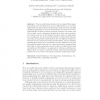Free Online Productivity Tools
i2Speak
i2Symbol
i2OCR
iTex2Img
iWeb2Print
iWeb2Shot
i2Type
iPdf2Split
iPdf2Merge
i2Bopomofo
i2Arabic
i2Style
i2Image
i2PDF
iLatex2Rtf
Sci2ools
EUROPAR
2003
Springer
2003
Springer
Parallelization with Tree Skeletons
Abstract. Trees are useful data structures, but to design efficient parallel programs over trees is known to be more difficult than to do over lists. Although several important tree skeletons have been proposed to simplify parallel programming on trees, few studies have been reported on how to systematically use them in solving practical problems; it is neither clear how to make a good combination of skeletons to solve a given problem, nor obvious even how to find suitable operators used in a single skeleton. In this paper, we report our first attempt to resolve these problems, proposing two important transformations, the tree diffusion transformation and the tree context preservation transformation. The tree diffusion transformation allows one to use familiar recursive definitions to develop his parallel programs, while the tree context preservation transformation shows how to derive associative operators that are required when using tree skeletons. We illustrate our approach by ...
| Added | 06 Jul 2010 |
| Updated | 06 Jul 2010 |
| Type | Conference |
| Year | 2003 |
| Where | EUROPAR |
| Authors | Kiminori Matsuzaki, Zhenjiang Hu, Masato Takeichi |
Comments (0)

